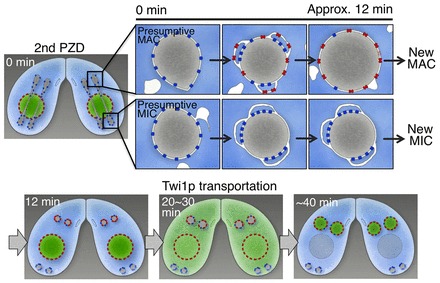Fig. 6.

Schematic summarizing early stages of nuclear differentiation. Pre-existing MIC-type NPCs (blue dots) are distributed equally to both daughter nuclei during the second PZD, as shown in the 0 min panel. At or immediately after the end of the second PZD, the pre-existing MIC-type NPCs form several clusters on each post-zygotic nucleus. Various membranes, including ER and vacuolar membranes, approach both nuclei and fuse to the NE to generate regions with redundant NE; the MIC-type NPCs are packed in clusters in the inner set of these redundant NEs. Newly synthesized MAC-type NPCs (red dots) assemble on the NE between 0 and 12 min after the end of the second PZD. Importantly, this de novo assembly of MAC-type NPCs occurs only in the anterior-localizing presumptive new MACs, but not in the posterior-localizing presumptive new MICs. Size expansion of the presumptive new MACs occurs at ∼12 min after the end of the second PZD. During this event the redundant NEs and NPC clusters in the presumptive new MACs are lost, but the redundant NE and NPC clusters remain unchanged in the presumptive new MICs. Twi1p, a factor required for MAC differentiation, is dispersed into the cytoplasm from the parental MAC and starts to be transported into the new MACs at ∼20–30 min after the second PZD. See also supplementary material Movie 2.
